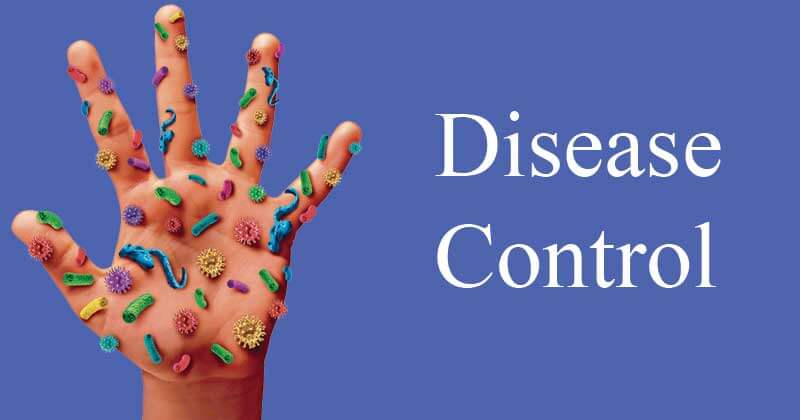- Control of communicable diseases, which implies reducing their occurrence, has always been a major public health priority.
- In the past, control measures were based on incomplete knowledge of the epidemiology of the disease to be controlled and were directed at perceived factors of disease causation.
- As knowledge of the epidemiology of diseases improved, and with the development of scientifically sound intervention techniques, it has been possible to direct specific control measures at factors related to the occurrence of particular diseases.
- With recent developments in disease control technologies, new and more optimistic targets for the reduction in the occurrence of a disease have been put forward, and the concept of eradication, which implies that the disease will no longer occur in a population, has been widely adopted.
- As applied to many communicable and some non- communicable diseases, the control means ongoing operations or programs aimed at reducing the incidence and/or prevalence of such diseases.
- Control may be looked upon as a process with different levels of reduction in frequency, reduction to a point where a disease ceases to become a major public health problem or reduction to a point of great rarity and extermination.
- In this sense elimination and eradication are the highest levels of control.
- Control of diseases thus refers to the actions and programs directed towards reducing disease incidence (new infections), reducing disease prevalence (infections in the community at any given point in time), or completely eradicating the disease.
- In 1998, Dowdle proposed a definition of control as a reduction in the incidence, prevalence, morbidity or mortality of an infectious disease to a locally acceptable level.
- When public health experts talk about controlling disease, they mean reducing the number of new infections, the number of people currently infected, and the number of people who become sick or die from a disease in local settings.
- This is achieved through deliberate efforts such as vaccines, medications, contact isolation, or other public health interventions.
- Malaria is a good example of a disease that can be controlled in local settings. You can’t get rid of malaria entirely because the mosquito-borne parasites that transmit the disease can develop drug resistance. But you can control it through health care and prevention strategies such as bed nets and anti-malarial medications.

Image Source: Medgadget, Inc.
Interesting Science Videos
Disease Control Methods
The term “disease control” describes (ongoing) operations aimed at reducing:
- The incidence of disease
- The duration of disease, and consequently the risk of transmission
- The effects of infection, including both the physical and psychosocial complications; and
- The financial burden to the community.
- Control activities may focus on primary prevention or secondary prevention, most control programs combine the two. The concept of tertiary prevention is comparatively less relevant to control efforts.
- In disease control, the disease “agent” is permitted to persist in the community at a level where it ceases to be a public health problem according to the tolerance of the local population.
- A state of equilibrium becomes established between the disease agent, host and environment components of the disease process.
- The infectious diseases may be prevented in one of two general ways:
- by preventing contact, and therefore transmission of infection, between the susceptible host and the source of infection and
- by rendering the host unsusceptible, either by selective breeding or by induction of effective artificial immunity. The nature of the specific preventive measures, and their efficacy, vary from one disease to another.
Health Promotion
- Health promotion is “the process of enabling people to increase control over, and to improve health”.
- It is not directed against any particular disease but is intended to strengthen the host through a variety of approaches (interventions).
- The well-known interventions in this area are:
- Health education
- Environmental modifications
- Nutritional interventions
- Lifestyle and behavioral changes
Specific Protection
- To avoid disease altogether is the ideal but this is possible only in a limited number of cases.
- The following are some of the currently available interventions aimed at specific protection:
- Immunization
- Use of specific nutrients
- Chemoprophylaxis
- Protection against occupational hazards
- Protection against accidents
- Protection from carcinogens
- Avoidance of allergens
- The control of specific hazards in the general environment, e.g., air pollution, noise control
- Control of consumer product quality and safety of foods, drugs, cosmetics, etc.
Early Detection and Treatment
- They are the main interventions of disease control.
- The earlier a disease is diagnosed and treated the better it is from the point of view of prognosis and preventing the occurrence of further cases (secondary cases) or any long-term disability.
- It is like stamping out the “spark” rather than calling the fire brigade to put out the fire.
Quarantine and Isolation
- Isolation and quarantine help protect the public by preventing exposure to people who have or may have a contagious disease.
- Isolation separates sick people with a contagious disease from people who are not sick.
- Quarantine separates and restricts the movement of people who were exposed to a contagious disease to see if they become sick.
References
- Park, K. (n.d.). Park’s textbook of preventive and social medicine.
- Gordis, L. (2014). Epidemiology (Fifth edition.). Philadelphia, PA: Elsevier Saunders.
- https://vaccine-safety-training.org/elements/articles/eradication-difference.html
- https://www.who.int/bulletin/volumes/84/2/editorial10206html/en/
- http://www.pedaids.org/2015/02/18/hiv-101-the-difference-between-control-elimination-and-eradication/
- https://ourworldindata.org/eradication-of-diseases
- https://www.ncbi.nlm.nih.gov/books/NBK525190/box/ch12.sec2.box1/?report=objectonly
- https://www.burnet.edu.au/programs/27_disease_elimination
- https://www.cdc.gov/mmwr/preview/mmwrhtml/su48a7.htm
- https://www.historyofvaccines.org/content/articles/disease-eradication
- https://www.cdc.gov/quarantine/index.html
